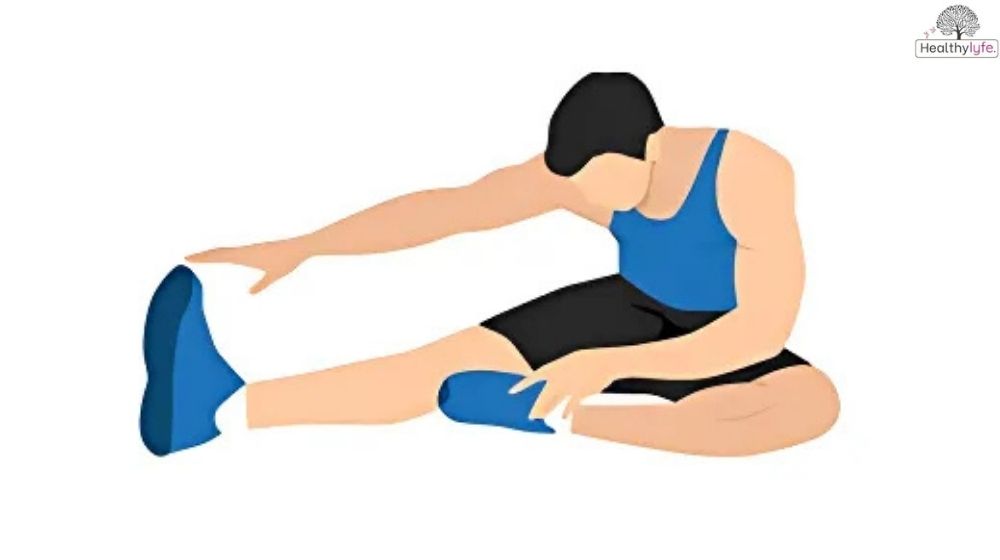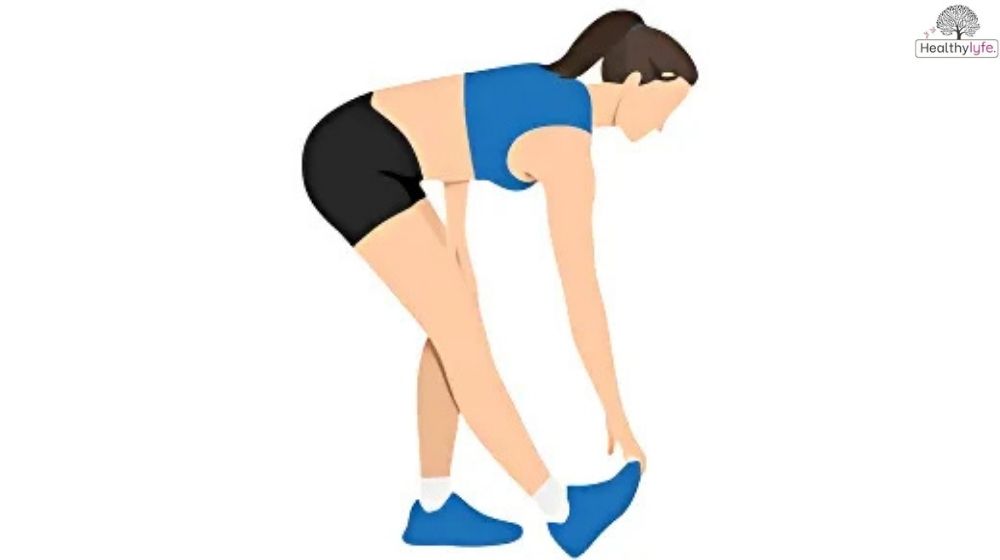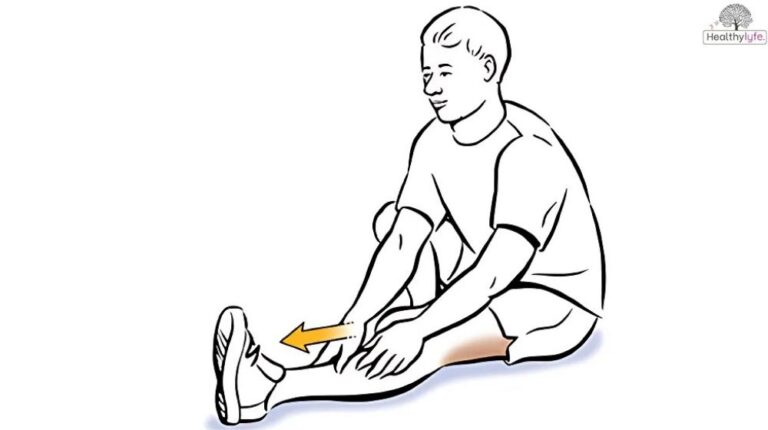A Complete Guide for Relieve Lover Back Pain , Tips and Common Mistake | By Healthylyfe
Try hamstring stretch to relieve lower back pain. This easy exercise reduces tension, improves flexibility, and helps prevent future discomfort.
Introduction
Lower back pain is a common ailment that affects people of all ages, often resulting from prolonged sitting, poor posture, or physical strain. One of the most effective ways to alleviate this discomfort is through targeted stretches that release tension and improve flexibility. Among these, hamstring stretches stand out as a simple yet powerful exercise for providing relief. Tight hamstrings can contribute to misalignment and stress in the lower back, exacerbating pain. Incorporating hamstring stretches into your routine not only helps reduce lower back discomfort but also enhances overall mobility and posture.
What is Hamstring Stretch?
A hamstring stretch is a simple exercise designed to lengthen and loosen the hamstring muscles, which run along the back of your thighs. These muscles play a crucial role in supporting your hips, knees, and lower back. When hamstrings become tight, they can pull on your pelvis and lower back, leading to discomfort or stiffness.
Hamstring stretches can be done in various positions, such as standing, sitting, or lying down, making them accessible for people of all fitness levels. Regularly practicing hamstring stretches can improve flexibility, reduce muscle tension, and support better posture and overall mobility.
Types of Hamstring Stretches
Hamstring stretches are essential exercises that help loosen tight muscles, improve flexibility, and reduce lower back pain. Here are some effective hamstring stretches you can try:

- Standing Hamstring Stretch
- Stand with one foot slightly in front of the other.
- Bend at the hips, keeping your back straight, and reach toward your front foot.
- Seated Hamstring Stretch
- Sit on the floor with one leg extended and the other bent.
- Lean forward from your hips, reaching toward your toes on the extended leg.
- Lying Hamstring Stretch with a Strap
- Lie on your back and loop a strap or towel around the arch of one foot.
- Straighten your leg toward the ceiling while keeping the other leg flat on the ground.
- Dynamic Leg Swings
- Stand upright and swing one leg forward and backward in a controlled motion.
- Downward Dog Stretch
- Start in a plank position, then lift your hips toward the ceiling to form an inverted V-shape.
- Keep your legs straight and press your heels toward the floor.
Understanding the Link Between Hamstrings and Lower Back Pain
Tight hamstrings can lead to lower back pain by pulling on the pelvis and causing it to tilt. This misalignment puts extra stress on the lower back, leading to discomfort and stiffness. Since hamstrings support your posture and movement, keeping them flexible is essential for preventing back pain.
Regular hamstring stretches help reduce tension, improve posture, and support a healthy lower back. Adding these simple exercises to your routine can make a big difference in relieving and preventing lower back pain.
Benefits of Hamstring Stretches [1]
Hamstring stretches offer many benefits that go beyond improving flexibility. Regularly stretching your hamstrings can help reduce back pain, improve posture, and prevent injury. Whether you’re sitting for long hours or staying active, hamstring stretches are an easy way to maintain your body’s health and mobility.
- Reduces Lower Back Pain
Tight hamstrings can cause poor posture and put extra stress on your lower back. Stretching them regularly helps release tension, reducing back pain and improving your alignment. - Improves Flexibility
Stretching the hamstrings helps increase muscle flexibility, making movements easier and reducing stiffness in your legs. - Prevents Injuries
Stretching keeps your hamstrings flexible and strong, lowering the risk of strains or tears during physical activities like running, jumping, or bending. - Boosts Posture
Tight hamstrings can cause your pelvis to tilt, leading to poor posture. Stretching them can help realign your pelvis, improving posture and reducing strain on your back and hips. - Increases Mobility
Regular hamstring stretches enhance your range of motion, helping you move more easily and comfortably throughout the day.
Common Mistakes to Avoid While Stretching
Stretching is a great way to improve flexibility, reduce muscle tension, and prevent injuries. However, doing stretches incorrectly can lead to discomfort or even injury. To make sure your stretching routine is safe and effective, it’s important to avoid some common mistakes.
Common Stretching Mistakes to Avoid
- Bouncing While Stretching
- Why it’s a mistake: Bouncing during a stretch can cause your muscles to contract instead of relax, increasing the risk of strain or injury.
- What to do instead: Always hold each stretch steadily for 20-30 seconds, without bouncing. This allows your muscles to fully relax and lengthen.
- Overstretching
- Why it’s a mistake: Stretching too far can cause muscles or tendons to stretch beyond their limits, leading to injury.
- What to do instead: Stretch to a point where you feel a mild stretch, not pain. Stop if you feel sharp discomfort.
- Holding Your Breath
- Why it’s a mistake: Holding your breath during a stretch can cause increased muscle tension, making the stretch less effective.
- What to do instead: Make sure to breathe deeply and steadily, helping your muscles relax and get the most out of each stretch.
- Not Warming Up Before Stretching
- Why it’s a mistake: Stretching cold muscles can lead to strains or injury.
- What to do instead: Always do a light warm-up, like walking or jogging, for 5-10 minutes before stretching. This increases blood flow to your muscles and prepares them for stretching.
- Ignoring Pain
- Why it’s a mistake: Stretching through pain can cause muscle damage or worsen existing injuries.
- What to do instead: If you feel sharp or intense pain while stretching, stop immediately. Stretching should never be painful. If the pain persists, consult a healthcare professional.
Tips for Relieving Lower Back Pain
Lower back pain is a common issue that many people face, whether from sitting too long, poor posture, or physical activity. Finding effective ways to relieve this pain can greatly improve your comfort and quality of life. Incorporating simple tips and lifestyle changes can help reduce discomfort, promote healing, and prevent future pain.

- Practice Good Posture
- Why it helps: Poor posture, especially while sitting or standing, puts strain on the muscles and ligaments in your lower back.
- What to do: Maintain a neutral spine when sitting or standing. Keep your shoulders back and avoid slouching. Use ergonomic chairs and tools to support proper posture throughout the day.
- Stretch and Strengthen Your Core
- Why it helps: A weak core can put extra pressure on your lower back, leading to pain.
- What to do: Perform exercises that strengthen your abdominal and back muscles, such as planks and bridges. Also, include gentle stretches for the hamstrings, hip flexors, and lower back to improve flexibility.
- Apply Heat or Cold
- Why it helps: Heat helps relax tight muscles, while cold reduces inflammation.
- What to do: Use a hot water bottle, heating pad, or warm bath to relax tense muscles. For inflammation or recent injury, apply an ice pack wrapped in a cloth for 15-20 minutes.
- Stay Active and Move Regularly
- Why it helps: Prolonged inactivity can worsen back pain. Gentle movement promotes circulation and reduces stiffness.
- What to do: Take short walks, stretch periodically, or do low-impact exercises like swimming or cycling. Avoid staying in one position for too long.
- Get a Good Night’s Sleep
- Why it helps: Poor sleep quality or uncomfortable sleeping positions can aggravate lower back pain.
- What to do: Sleep on a firm mattress and try sleeping on your side with a pillow between your knees. Make sure your pillow supports your neck properly.
- Maintain a Healthy Weight
- Why it helps: Carrying excess weight puts extra strain on your lower back.
- What to do: Eat a balanced diet and engage in regular exercise to maintain a healthy weight. This will help reduce the load on your lower back.
Conclusion
Hamstring stretches are an effective way to ease lower back pain. Tight hamstrings can pull on your lower back, causing discomfort. By regularly stretching your hamstrings, you can reduce this tension and improve flexibility. This helps relieve pain and prevent future discomfort. Adding hamstring stretches to your routine is a simple yet powerful way to support a healthier, pain-free lower back.
FAQs about Hamstring Stretch
How do hamstring stretches help with lower back pain?
Hamstring stretches relieve tension in the muscles behind your thighs, which can help reduce strain on your lower back.
How often should I do hamstring stretches for back pain relief?
Aim to stretch your hamstrings at least 3-4 times a week for the best results.
Can hamstring stretches prevent lower back pain?
Yes, regularly stretching your hamstrings helps keep muscles flexible, reducing the risk of lower back pain.
How long should I hold a hamstring stretch?
Hold each stretch for 20-30 seconds to allow your muscles to relax and lengthen properly.
Is it safe to stretch if I already have lower back pain?
Yes, as long as you don’t push yourself too far. Start gently and stop if you feel any sharp pain.
What is the best hamstring stretch for back pain relief?
The seated hamstring stretch or lying hamstring stretch with a strap are great options for relieving back pain.
Can I stretch my hamstrings if I have tight lower back muscles?
Yes, stretching your hamstrings can help ease the tension in your back by reducing the strain caused by tight muscles.
Are there any risks to stretching my hamstrings too much?
Stretching too aggressively can lead to muscle strain. Always stretch to the point of mild discomfort, not pain.
Should I warm up before doing hamstring stretches?
Yes, it’s best to warm up with light activity like walking to get your muscles ready for stretching.
Can hamstring stretches improve posture?
Yes, hamstring stretches can help improve posture by reducing tension that may cause pelvic misalignment.
How can I know if I’m stretching my hamstrings correctly?
If you feel a gentle stretch in the back of your thigh without pain in your lower back, you’re likely stretching correctly.
Is it better to stretch in the morning or evening for lower back pain relief?
Stretching anytime during the day is beneficial, but stretching in the morning can help reduce stiffness and improve mobility.
Can hamstring stretches help with sciatica?
Yes, stretching your hamstrings can help relieve pressure on the sciatic nerve, easing sciatic pain.
Should I do other stretches along with hamstring stretches for back pain?
Yes, incorporating stretches for the lower back, hip flexors, and quads can further relieve back pain.
How soon will I feel relief from lower back pain after doing hamstring stretches?
You may start feeling relief after a few sessions, but consistent stretching over time will lead to lasting results.
Disclaimer: The information provided in this article is for general informational purposes only and is not intended as medical advice. Always consult with a healthcare professional or certified fitness trainer before starting any new exercise,
By healthylyfe


